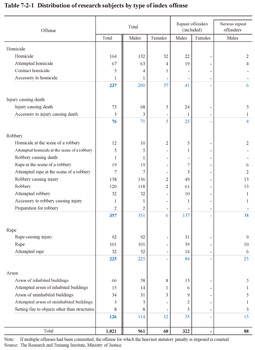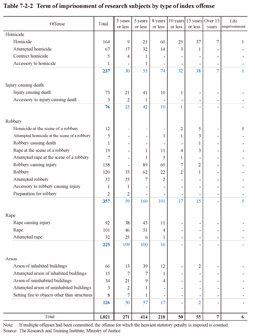Chapter 2 Actual Situation concerning Serious Offenses and Repeat Offenses
The actual situation concerning serious offenses was outlined in the previous chapter. This chapter analyses factors that increase the risk of a repeat offense and factors that facilitate/obstruct (prevent) reformation/rehabilitation through investigating the situation with repeat offenses after researching the attributes, concrete situation with offenses, and situation with treatment in correction and probation/parole supervision, etc. through conducting special research on persons imprisoned for serious offenses in thus contributing to a discussion on the effective treatment for serious offenders.
The outline of the special research is as follows.
The research subjects were persons who had been convicted in a final judgment for serious offenses (homicide, injury causing death, robbery, rape, and arson) and imprisoned, and then released from penal institutions nationwide in the first half of 2000 (from January to June). The total number of research subjects was 1,021. Research subjects who had been imprisoned for multiple serious offenses (for example for homicide and rape) were subjected to analysis of each type of the offense they committed in examining the characteristics for the individual type of offense.
The research/analysis methods were as follows. The circumstances of the offense, including the nature and motives, etc., a history of previous convictions and their details, employment/residential status at the time of the offense, sentencing, etc. were first examined with regard to the serious offenses that had been committed by the research subjects (offenses that led to their imprisonment). Next the status of the treatment made available to the research subjects at penal institutions and the status of their release, etc. were examined using penal institute records. In addition, the status of treatment in parole supervision, including the term, assignment of special conditions, guarantors, and employment status, etc., of 750 research subjects who had been granted parole were examined using probation office records. The situation with repeat offenses and the period until they were repeated of 322 repeat offenders were then examined using public prosecutors office records and the factors involved in the repeat offenses were analyzed by comparing those who had repeated offenses with those who had not. Here, to “repeat offenses” refers to being sentenced to imprisonment or a heavier punishment in a final judgment by the end of 2009 (until approximately 10 years after being released) for an offense (excluding negligence in vehicle driving / negligence in the pursuit of social activities causing death or injury and violations of traffic related acts) they committed after being released from a penal institution.
Table 7-2-1 shows the number of offenders and repeat offenders by the type of the serious offense committed by the research subjects (may hereinafter be referred to as “index case” or “index offense” in this part) and Table 7-2-2 the number of offenders by sentencing for index offenses. Note that sentencing in this Table indicates that given to the research subjects who were imprisoned until the first half of 2000, and actually significantly differs from sentencing for serious offenses in recent years (See Section 2, Chapter 1) as it is generally less severe, especially for rape.
Table 7-2-1 Distribution of research subjects by type of index offense
Table 7-2-2 Term of imprisonment of research subjects by type of index offense

